
by Laura Tiu | May 13, 2022
The northwest Florida area has been identified as having the highest concentration of invasive lionfish in the world. Lionfish pose a significant threat to our native wildlife and habitat with spearfishing the primary means of control. Lionfish tournaments are one way to increase harvest of these invaders and help keep populations down. Not only that, but lionfish are a delicious tasting fish and tournaments help supply the local seafood markets with this unique offering.
Since 2019, Destin, Florida has been the site of the Emerald Coast Open (ECO), the largest lionfish tournament in the world. While the tournament was canceled in 2020, due to the pandemic, the 2021 tournament and the Lionfish Removal and Awareness Day festival returned to the Destin Harbor and led to the removal of over 10,000 invasive lionfish.
This weekend, May 14 and 15, 2022, the tournament and festival will be in back in full force at HarborWalk Village in Destin Harbor. A record number of teams will be on the water competing for cash prizes and other loot. Florida Sea Grant will be on hand to support the two-day festival that will include lionfish tasting and fillet demonstrations, conservation and art booths, interactive kids zone, shopping, and lionfish viewing! Bring your family and friends out to support this unique event and do your part to help fight invasive lionfish.
For more information on the tournament, visit EmeraldCoastOpen.com or Facebook.com/EmeraldCoastOpen.
For information about Lionfish Removal and Awareness Day, visit FWCReefRangers.com
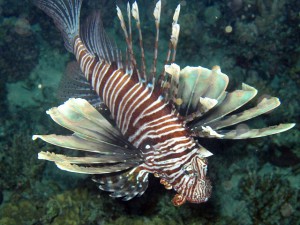
The Invasive Lionfish
“An Equal Opportunity Institution”
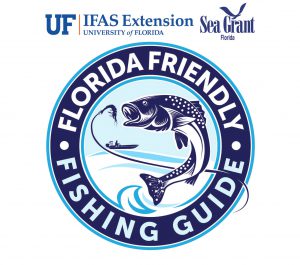
by Laura Tiu | Jul 3, 2020
Fishing is big business in Florida, contributing billions of dollars each year to the state’s economy. Fishing guides are an important part of the fishing industry. Guides provide locals and tourists alike with authentic Florida fishing experiences and memories that last a lifetime. Fishing guides are role models that can teach ethical angling through their onboard behaviors.
The Florida Friendly Fishing Guides Certification was developed by the University of Florida IFAS Extension, Florida Sea Grant, and the Florida Fish and Wildlife Conservation Commission with input from fishing guides. It is a voluntary certification program and involves no regulatory component. The target audience is flats guides, charter boat captains, and head-boat captains and crew. Recreational fishers are welcome to take the course, too.
What will I learn?
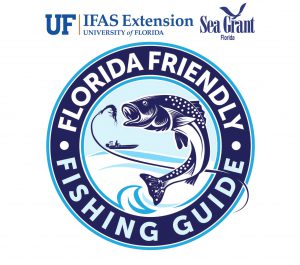 The Florida Sea Grant Florida Friendly Fishing Guide online course teaches best practices for catch and release fishing. Each lesson plan focuses on a different aspect of ethical angling. There are modules on seafood safety, federal and state fisheries management, onboard waste management, and how to teach your customers about the environment.
The Florida Sea Grant Florida Friendly Fishing Guide online course teaches best practices for catch and release fishing. Each lesson plan focuses on a different aspect of ethical angling. There are modules on seafood safety, federal and state fisheries management, onboard waste management, and how to teach your customers about the environment.
One environmental impact of fishing is what we call discard mortality. This is when a caught fish is released but does not survive. You will learn how to increase fish survival, how to identify barotrauma, and how to use descending and venting tools.
Starting July 15, 2020, a descending device will be required for head-boats, charter boats, commercial, and recreational vessels fishing for reef fish in federal waters of the Atlantic Ocean from North Carolina to Florida. The Florida Friendly Fishing Guide course will teach you how to identify barotrauma and select the right tool for sending fish back down to depth! Proper fish handling skills are important because up to 60% of caught fish are released.
The cost is $130 and the course takes about 4 hours to complete. Once you complete the course you receive a welcome package, public listing on the Florida Sea Grant website, and an optional social media promotion. For more information and registration go to https://www.flseagrant.org/florida-friendly-fishing-guide-certification/ or contact your local Florida Sea Grant agent, Laura Tiu, lgtiu@ufl.edu. Florida Friendly Fishing Guide Certification is a state-wide program for all saltwater fishing guides in Florida.
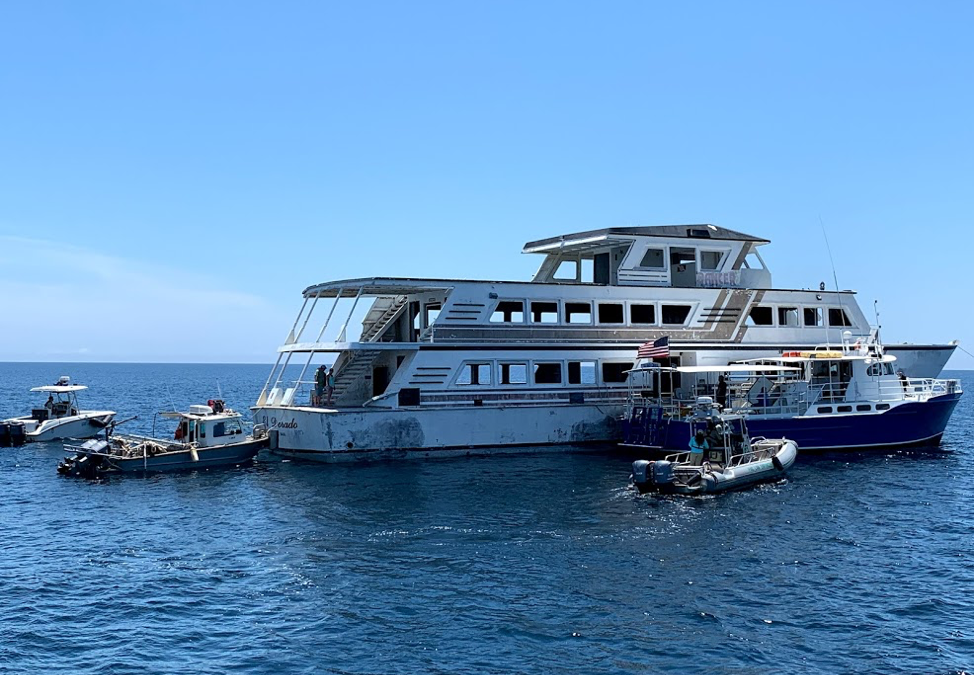
by Scott Jackson | Jun 21, 2019
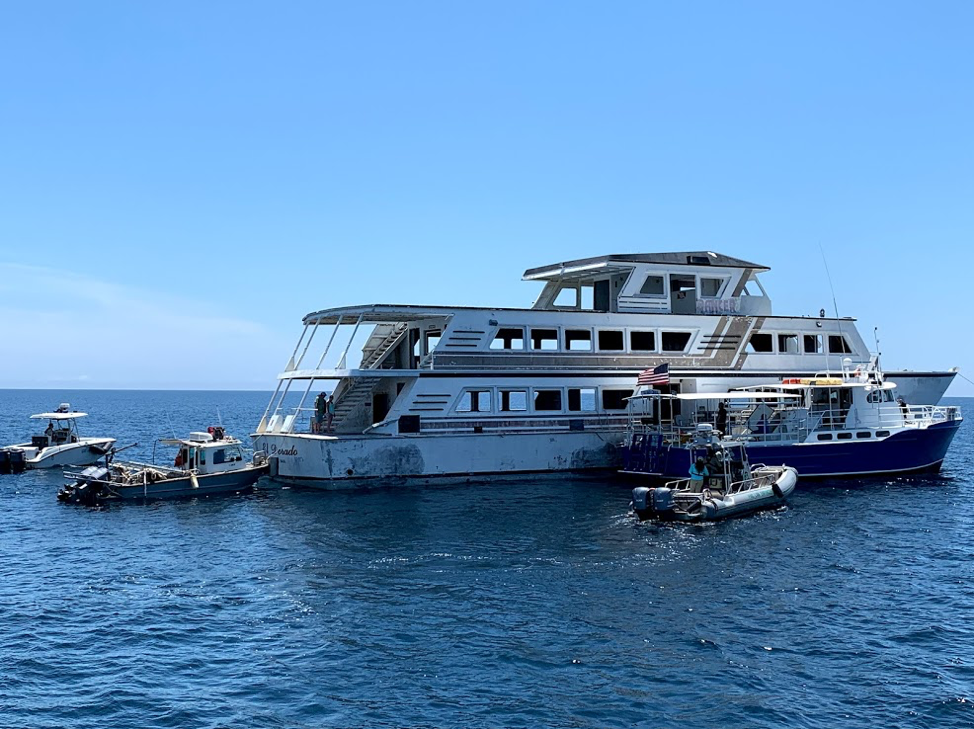
Panama City Dive Center’s Island Diver pulls alongside of the El Dorado supporting the vessel deployment by Hondo Enterprises. Florida Fish and Wildlife crews also are pictured and assisted with the project from recovery through deployment. The 144 foot El Dorado reef is located 12 nautical miles south of St Andrew Pass at 29° 58.568 N, 85° 50.487 W. Photo by L. Scott Jackson.
In the past month, Bay County worked with fishing and diving groups as well as numerous volunteers to deploy two artificial reef projects; the El Dorado and the first of the Natural Resources Damage Assessment (NRDA) reefs.
These sites are in Florida waters but additional opportunities for red snapper fishing are available this year to anglers that book for hire charters with captains holding federal licenses. Federal licensed Gulf of Mexico charters started Red Snapper season June 1st and continue through August 1st. Recreational Red Snapper fishing for other vessels in State and Federal waters is June 11th – July 12th. So booking a federally licensed charter can add a few extra fish to your catch this year.
The conversion of the El Dorado from a storm impacted vessel to prized artificial reef is compelling. Hurricane Michael left the vessel aground in shallow waters. This was in a highly visible location close to Carl Grey Park and the Hathaway Bridge. The Bay County Board of County Commissioners (BOCC) acquired the El Dorado, January 14, 2019 through negotiations with vessel owner and agencies responsible for recovery of storm impacted vessels post Hurricane Michael.
The El Dorado was righted and stabilized, then transported to Panama City’s St Andrews Marina by Global Diving with support from the Coast Guard and Florida Fish and Wildlife. Hondo Enterprises, was awarded a contract to complete the preparation and deployment of the vessel for use as an artificial reef.
Reefing the El Dorado provides new recreational opportunities for our residents and tourists. The new reef delivers support for Bay County’s fishing and diving charters continuing to recover after Hurricane Michael. Several local dive charter captains assisted in the towing and sinking of the El Dorado.
The El Dorado was deployed approximately 12 nm south of St. Andrew Bay near the DuPont Bridge Spans May 2, 2019. Ocean depth in this area is 102 feet, meaning the deployed vessel is accessible to divers at 60 feet below the surface.
The Bay County Board of County Commissioners continues to invest in the county’s artificial reef program just as before Hurricane Michael. Additional reef projects are planned for 2019 – 2020 utilizing Natural Resources Damage Assessment (NRDA) and Resources and Ecosystems Sustainability, Tourist Opportunities, and Revived Economies of the Gulf Coast States Act (RESTORE Act) funds. These additional projects total over 1.3 million dollars utilizing fines as a result of the Deepwater Horizon Oil Spill. Deployments will occur in state waters in sites located to both the east and west of St. Andrew Bay Pass.
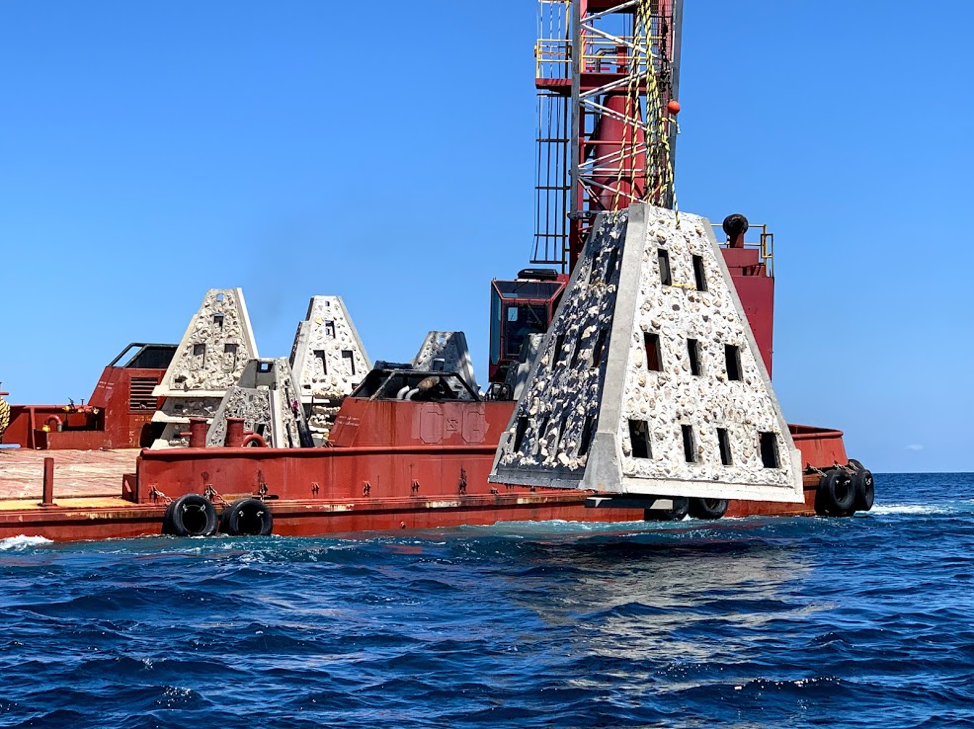
Walter Marine deploys one of nine super reefs deployed in Bay County’s NRDA Phase I project located approximately 12 nautical miles southeast of the St. Andrew Pass. Each massive super reef weighs over 36,000 lbs and is 15 ft tall. Multiple modules deployed in tandem provides equivalent tonnage and structure similar to a medium to large sized scuttled vessel. Photo by Bob Cox, Mexico Beach Artificial Reef Association.
The first of these NRDA deployments for Bay County BOCC was completed May 21, 2019 in partnership with Mexico Beach Artificial Reef Association, Florida Fish and Wildlife Conservation Commission, and Florida Department of Environmental Protection using a $120,000 portion of the total funding. The deployment site in the Sherman Artificial Reef Permit Area is approximately 12 nm south east of St Andrew Bay Pass at a depth of 78 – 80ft.
| Patch Reef # |
Latitude |
Longitude |
| BC2018 Set 1
(6 Super Reefs and 4 Florida Specials) |
29° 55.384 N |
85° 40.202 W |
| BC2018 Set 2
(1 Super Reef and 4 Florida Specials) |
29° 55.384 N |
85° 39.739 W |
| BC2018 Set 3
(1 Super Reef and 4 Florida Specials) |
29° 55.384 N |
85° 39.273 W |
| BC2018 Set 4
(1 Super Reef and 4 Florida Specials) |
29° 55.384 N |
85° 38,787 W |
In 2014, Dr. Bill Huth from the University of West Florida, estimated in Bay County the total artificial reef related fishing and diving economic impact was 1,936 jobs, $131.98 million in economic output and provided $49.02 million in income. Bay County ranked #8 statewide in artificial reef jobs from fishing and diving. Bay County ranked #3 in scuba diving economy and scuba diving was 48.4 % of the total jobs related to artificial reefs. Dr. Huth also determine that large vessels were the preferred type of artificial reef for fishing and diving, with bridge spans and material the next most popular. Scuba diving and fishing on artificial reefs contributes significantly to the county’s economic health.
For more information and assistance, contact UF/IFAS Extension Bay County at 850-784-6105 or Bay@ifas.ufl.edu. Follow us on Facebook at http://faceboook.com/bayifas .
An Equal Opportunity Institution. UF/IFAS Extension, University of Florida, Institute of Food and Agricultural Sciences, Nick T. Place, Dean for UF/IFAS Extension. Single copies of UF/IFAS Extension publications (excluding 4-H and youth publications) are available free to Florida residents from county UF/IFAS Extension offices.
This article is also available through the the Panama City New Herald
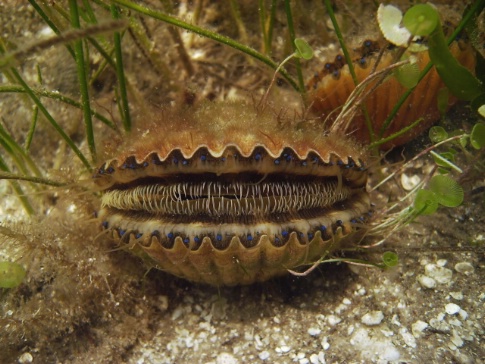
by Mark Mauldin | Jul 1, 2016

Bay Scallop Argopecten iradians
http://myfwc.com/fishing/saltwater/recreational/bay-scallops/
If you had plans to go scalloping in St. Joseph Bay over the long holiday weekend I’m afraid you are going to be disappointed. FWC has postponed the opening day of scallop harvesting season in St. Joseph Bay until August 22.
The postponement, along with other conservation efforts, is intended to provide the scallop population in St. Joseph Bay additional time to recover from the effects of the Red Tide event we experienced last fall. Scallop season in St. Joseph Bay will start later, end earlier, and have tighter bag limits than the rest of the Bay Scallop Harvest Zone – “the Pasco-Hernando County line (near Aripeka – latitude 28 degrees, 26.016 minutes North) to the west bank of the Mexico Beach Canal in Bay County (longitude 85 degrees, 25.84 minutes West)”(FWC). Below are several figures regarding the 2016 Bay Scallop season in St. Joseph Bay. All of the figures are courtesy of FWC.
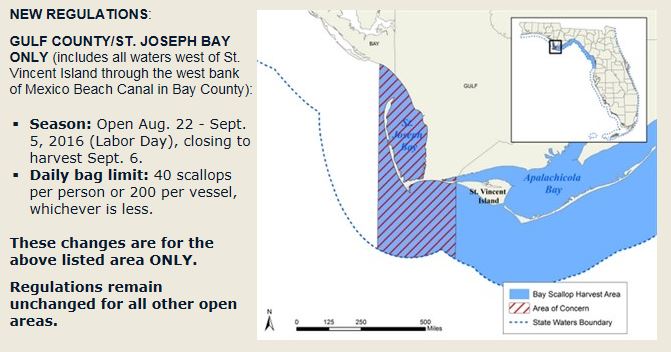
http://myfwc.com/fishing/saltwater/recreational/bay-scallops/
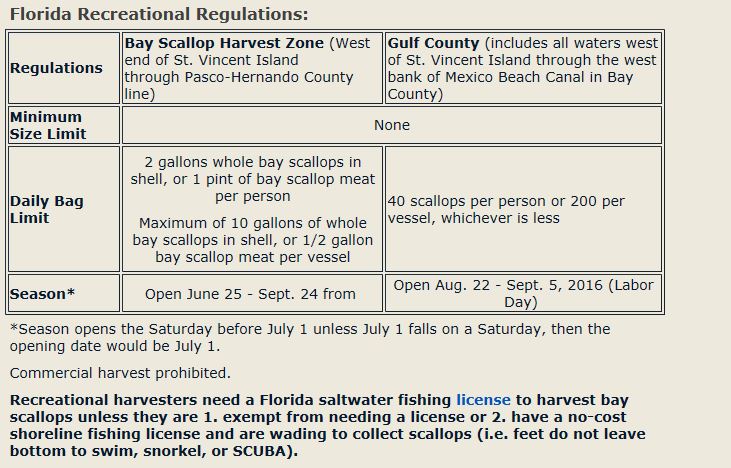
http://myfwc.com/fishing/saltwater/recreational/bay-scallops/

http://myfwc.com/fishing/saltwater/recreational/bay-scallops/
Here’s the bright side, even with scalloping on hold for a while, here in NW Florida we have tons of other opportunities for fun on the water. If you were ready to go scalloping then you likely already have a saltwater fishing license, a boat, and a family that is ready to go have fun. You can still put all of these to good use – go fishing.
One of the most attractive aspects of scalloping is that it is, quite frankly, easy. It’s fun for the whole family, even those with shorter attention spans. Fishing can be easy too, if you target the right species. When looking to entertain the family don’t think about trying to catch the trophy that will be the envy off all your friends, think about fish that are easy to find and eager to bite. The following are a few species to target that I think fit this scenario nicely.
Sand Perch – If you are dealing with anglers that are very inexperienced and casting is an issue Sand Perch are an excellent option. They prefer deeper bay waters with sandy bottoms. The deeper water allows for bait to be dropped vertically, no casting necessary. ½ of a live shrimp on a #2 or 1/0 hook with enough weight to get to the bottom, is all you need. These little guys bite very aggressively and generally when you find one there will be many more in the area. If you want fish for supper, Sand Perch taste very good but the smaller ones have very little meat.
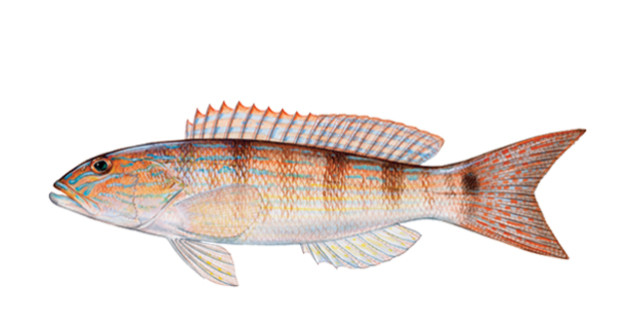
Sand Perch – Diplectrum formosum http://floridasportfishing.com/sand-perch/
Ladyfish – The “poor man’s tarpon” is often found over the same flats where you would go to find scallops but likely in slightly deeper water. These acrobatic fish will readily eat a wide variety of offerings, anything resembling a shrimp or bait fish (live or artificial), as long as it is moving up in the water column, not lying on the bottom. Ladyfish generally travel in schools and put on quite a show when hooked. Unfortunately, they are generally considered unfit to eat and they have a nasty habit of defecating when they are lifted from the water. (When I hook one I generally fight it to the boat, then give it some slack line which it will use to sling the hook from its mouth, thereby avoiding having to lift the fish from the water and the subsequent mess.) Mess aside, these fish are really a lot of fun to catch.
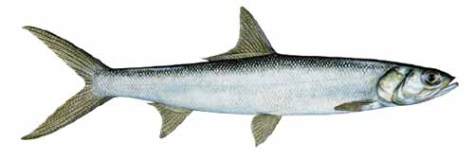
Ladyfish – Elops saurus
http://www.captivafishing.net/?p=772
Spotted Sea Trout – A game species that is highly regarded throughout the coastal waters of Florida that is almost two fish in one. Big, “gator” trout are widely sought by anglers and can be very difficult to catch; that’s not the fish we’re after here. Juvenile trout are much easier to catch than their more mature counterparts. A live or artificial shrimp drifted under a cork over seagrass beds is a simple but very effective recipe for catching trout. Most “serious” anglers will leave an area when they start to catch “shorts”, that’s exactly where you want to be for lots of fast paced action. Just because they are small doesn’t mean they are not fun to catch. A couple of things to remember with trout; 1) they are a regulated species so make sure you know the rules if you are planning on keeping fish, 2) they are fairly fragile fish and should be handled gently with wet hands and returned to the water quickly. Visit catchandrelease.org for additional fish handling tips.
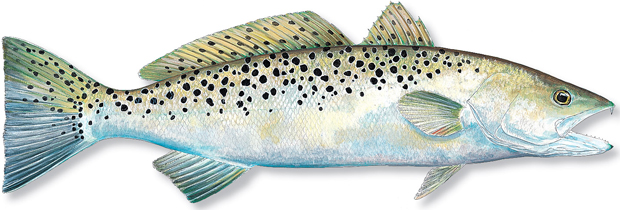
Spotted Sea Trout – Cynoscion nebulosus
http://www.floridasportsman.com/sportfish/seatrout/
There are many other species that I could have mentioned; catfish, bluefish, blue runners, and even pin fish can all help make for a day on the water fun for the whole family. It’s all about mindset, look for lots bites and bent poles not trophies. Don’t let the delay of scallop season delay your family’s fun on the water this summer – go fishing.
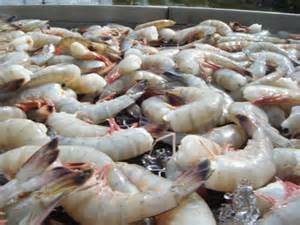
by Rick O'Connor | Sep 20, 2015
Yea, seafood… who doesn’t like seafood… actually, based on a small scale survey I conducted with marine science students over the last 28 years I have found a slight increase in the number of those who do not. Curious about this, I followed up by asking whether their concern was seafood safety or other. Almost all said they just did not like the taste. Okay… I can take that… there are something I do not like either BUT I LIKE SEAFOOD. The survey also showed that almost every year with young/old or male/female – shrimp was at the top of their favorite list. After shrimp the next 3-4 choices for males was some type of fish. For females it varied – fish, lobster, calamari, to name a few.
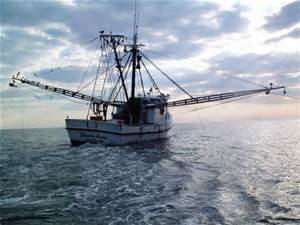
Shrimping depends on healthy estuaries.
Photo: NOAA
So what does this have to do with estuaries…
Well, you may not know this but 90% of the commercial important marine species require estuaries for at least part of their life cycles. Just as humans select a neighborhood to live and raise their kids based on safety and schools – “fish parents” find everything they want for their “kids” in an estuary. They are shallow – allowing light to reach much of the bottom where submerged plants, like seagrasses, can grow. These seagrasses provide hiding places and a place for small algae to attach – which is an important food source for many of them. There are other places for them to hide as well – emergent salt marshes and oyster reefs are biologically very productive habitats. Many of the developing larva and juveniles require lower salinities to begin and complete their life cycles; venturing to the open Gulf only when they have developed a tolerance for the higher salinities. The freshwater discharge not only lowers the salinity it also brings nutrients. These nutrients, along with the sunlight reaching much of the water column, produce an abundance of microscopic plankton – food for the young. The nutrients, thermal mixing, low salinities, and variety of habitats provide a combination for one of the most biologically diverse ecosystems on the planet – a great place to grow up… and much of it we enjoy eating.
Most of what we consume in the seafood world is divided into shellfish and finfish. Some of it is harvested and sold commercially, some we collect recreationally. In the shellfish world we are talking mollusk and crustaceans – two of the most popular seafood groups on the planet. The mollusk include snails, oysters, clams, mussels, scallops, and cephalopods like squid and octopus. Many of these species live in our estuaries their entire life cycle. Most are slow moving creatures – if they move at all – and have provided a living for some humans, recreation for many, for decades – though the landings of these species are on the decline… more on this in a later issue.
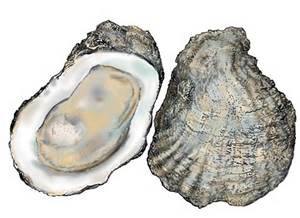
Oysters are one of the more popular shellfish along the panhandle.
Photo: FreshFromFlorida
Crustaceans include the ever popular gulf shrimp. We actually have three different species of bay shrimp we like – white, brown, and pink shrimp. There are other varieties found offshore we are now consuming, but these have been the big three. Blue crab – my personal favorite – is another popular crustacean. Though these are still harvested commercially, “crabbing” with your kids is a long time popular panhandle activity – and the day always ends well with a great meal. Crustaceans are more mobile and conduct small migrations during their life cycles. Shrimp develop within the estuary and then move offshore for breeding where the incoming tide brings the larva back to the estuary. Blue crabs migrate to the head of the bay for breeding and the females return to the lower end of the estuary for egg development and larva release – they may enter the Gulf during this process but tend to stick to the bays for the entire cycle.
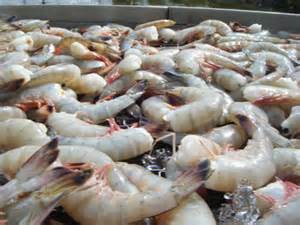
The famous Gulf Coast shrimp.
Photo: Mississippi State University
In the finfish world we are talking drum, snapper, grouper, trout, whiting, mullet, flounder, sheepshead, and many more. These species have provided both a living for the commercial fishermen and recreation for families for years. Many species breed and grow within the estuary while others make trips in and out of the bay to complete their cycles. In addition to commercial and family recreation charter fishing has increased as a business along the Gulf coast.
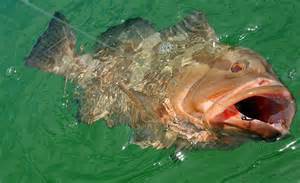
One of the more popular finfish – the grouper.
Photo: Bay County Extension, UF IFAS
We hope you and your family enjoy local seafood from our bays. There are several websites and apps, such as Seafood@Your Fingertips, that can help you locate local seafood – or you can go catch some yourselves! If harvesting recreationally be reminded that there are regulations and licenses required. You can read more about those at MyFWC.com.



















